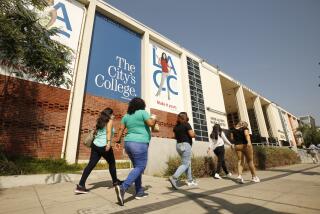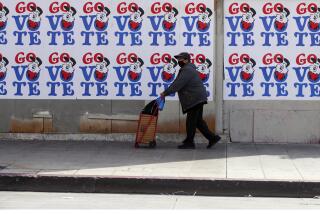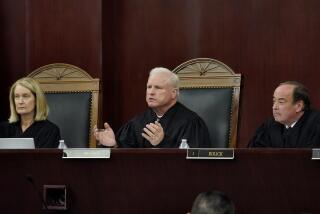Endorsement: The Times’ picks in June’s judicial races
- Share via
How is a voter to separate the good judicial candidates from the bad ones?
Rarely are there candidate forums, so there are few chances to make comparisons or ask questions. There is little news reporting about judges or judicial races, so reliable and even-handed information is scarce.
The Times editorial page does its best to help voters make their decisions by interviewing each candidate for Los Angeles Superior Court, talking with lawyers who have worked with and against them in court, weighing their knowledge, competence, integrity, temperament and demeanor, and recommending the candidate we believe to be the best of those running for each seat.
Read the rest of our judicial ensorsements here>>>
We divide our endorsements in the seven judicial races on the 2016 ballot in two, and focus here on the three seats in which lawyers have challenged judges who already have been sitting and serving.
------------
For the Record
April 27, 11:25 a.m.: An earlier version of this editorial incorrectly stated that there were six judicial races on the 2016 ballot, including three open seats. There are seven, four of which involve open seats.
------------
A challenger should have a good reason for seeking to oust an incumbent judge. California’s hybrid judicial selection system, in which the governor appoints most trial judges but the people can remove them in elections, strikes a delicate balance between judicial independence and public accountability. Worrying about potential challenges could easily make judges handle their rulings differently by focusing on possible voter reaction rather than the merits of the case.
About 150 Los Angeles Superior Court judges are approaching the end of their terms and are up for reelection, but most were not challenged for reelection and will automatically get another six-year term. Their names won’t even appear on the ballot. James Kaddo, Ray Santana and Kathryn Ann Solorzano were not so lucky. Each drew a single challenger.
Our recommendations:
Office 60: James Kaddo
This is one of those judicial races in which the challenger’s explanations for running, and for targeting a particular judge, are almost funny — or would be, if they didn’t force Kaddo, a capable judge for more than 25 years, to raise money and campaign in order to continue serving Los Angeles.
It’s not as though challenger Stepan W. Baghdassarian is qualified to replace him. Baghdassarian wasn’t even an active member of the State Bar of California until late last year, having given up his law practice long ago to run a wine importing business. Now he wants to be a judge.
Why challenge Kaddo? Nothing personal, he insists. It’s just that he’s an immigrant from Lebanon and wants to repay his adopted nation for the opportunity it has given him. That’s nice, but it doesn’t explain why out of the 150 other judges he could have challenged, or any of the three vacant seats he could have sought, he decided instead to run against L.A.’s only judge who also just happens to be an immigrant from Lebanon. Either there is a story here that neither candidate is telling us, or Baghdassarian has an odd sense of humor.
As an alternative explanation, Baghdassarian notes that he lives in the Valley, and Kaddo sits in Van Nuys, so it makes sense for him to seek that seat rather than one in Lancaster, Pomona or somewhere else. Nice try, but judicial offices are not tied to a particular courthouse, and any judge elected to this seat could be assigned to sit anywhere in the county. Baghdassarian has no business being a judge in Van Nuys, Pomona or anywhere else in Los Angeles County.
Office 120: Ray Santana
Judge Ray Santana was appointed to the bench in 2008 and was reelected without opposition to a full term in 2010. In recent months, though, illness has kept him from his duties. That may be one reason why private practitioner Eric O. Ibisi filed to run against him.
Or not. Ibisi has run a stealth campaign, or rather, no campaign at all, declining to make his case as to why he is qualified to be a judge, why Santana ought to be removed or why he believes he would do a better job. It is left to voters to ferret out that his practice includes criminal defense, that his office is near MacArthur Park and that he is a graduate of Pepperdine University Law School.
Santana is a former deputy public defender who earned his law degree from UC Berkeley. While he was presiding, he was a well-regarded judge. He told The Times that he intends to resume his duties in June.
Concern about his ability to serve might give voters some pause when deciding whether to reelect him — or it would, if there were a capable challenger ready to take his place. Ibisi offers nothing to suggest that he is that capable challenger.
Office 165: Kathryn Solorzano
Some courtrooms can be described as lax, with conversations going on about the room and judges waiting patiently on the bench for lawyers who are late for their scheduled hearings. Kathryn Solorzano’s criminal courtroom at the Airport Courthouse on La Cienega Boulevard is not one of those. Lawyers who arrive late, perhaps because they were completing a hearing in another courtroom, will hear about it.
Deputy Public Defender Tami L. Warren was one such lawyer. Now she has challenged Solorzano. But while Warren has some impressive credentials, she has failed to make either the case that she would be a better judge than Solorzano or that Solorzano ought to be removed.
Solorzano was a well-regarded Los Angeles deputy district attorney for 17 years and has served ably on the bench for the last decade. It would be a mistake for voters to oust her merely because she runs a tight ship.
In addition to these races, there are four open judicial seats, in which candidates are vying for positions soon to be vacated. The Times will publish its endorsement in those races later this week.
Follow the Opinion section on Twitter @latimesopinion and Facebook
More to Read
A cure for the common opinion
Get thought-provoking perspectives with our weekly newsletter.
You may occasionally receive promotional content from the Los Angeles Times.










